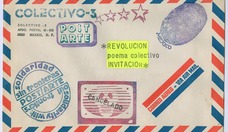These three key texts, selected by Vanessa Davidson, Shawn and Joe Lampe Curator of Latin American Art at the Phoenix Art Museum, outline Argentine experimental artist Edgardo Antonio Vigo’s understanding of mail art. Vigo explores what he calls “distance communication” as a new form for the development of art, communication, and political action.
Arte-Correo: Una nueva forma de expresión (Mail Art: A New Form of Expression)
By Edgardo Antonio Vigo and Horacio Zabala, 1975, 1976
Publication: Poetas Argentinos, Buzón de Arte
Language: Spanish
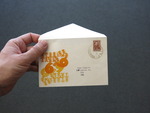
People communicate by exchanging messages, employing a variety of signs with various meanings. By “vocalizing” our thoughts, we speak words for others.
Our intention here is not to wade into this broad and complex topic but instead to analyze the interaction between two communication systems, each with a clear function and operating in a different sphere.
Sending a letter by mail involves the transmission of a message and is an act of communication between two people. The use of the mail makes communication possible at a distance: it connects a sender and a recipient. The artist produces his work in the same way that people “vocalize” their thoughts. The artistic instance also involves a sender and a recipient, necessary elements in any act of communication. In the same way that man, when attempting to express himself, does so by seeking out multiple channels, the artist gives expression to his creativity through multiple forms. Both organize and contribute to the creation of language in the search for new codes. An example can be found in the research of the visual artist who employs “conventionally non-artistic” mediums, altering their function. Proof of this last point can be found in the synthesis that has been achieved in this new expressive form, MAIL ART. Here we find a convergence of two systems of communication: the artist employs the mail to disseminate a message, to reach the recipient of the work. It is necessary to draw a distinction in order to clarify this concept. When a sculpture is sent by mail, its creator is merely using a particular form of transport to transfer a work that has already been completed. This journey was not taken into account during the sculpture’s elaboration. By contrast, in the new artistic language analyzed here, the fact that the work must travel a set distance is part of its structure, is the work itself. The work has been created to be sent by post, and this factor conditions its creation (dimensions, postage, weight, content of the message, etc.).
The mail’s function, therefore, is not limited to transporting the object; instead, this function forms part of the work and conditions it. In turn, the artist alters the function of this medium of communication. There is also a change in the attitude of the recipient: he is no longer the classic collector (a fact that implies a degree of egocentricity), but an incidental custodian of the work, committed to its widest possible distribution. The recipient is a new source of information that opens a new communication circuit when he enriches the work by exhibiting it or mailing it to additional recipients.
HISTORICAL OVERVIEW
It is difficult to establish dates, but we can speak of an increasing rise in MAIL ART in recent years, during which time exhibitions dedicated exclusively to this form have been staged: Biennale de Paris, sectio [sic] MAIL ART, 1971, France; An International Cyclopedia of Plans and Occurrences, Anderson Gallery, Richmond, 1973, USA; Omaha Flow Systems, Joslyn Museum, Omaha, 1973, USA; First Annual Toronto Correspondence and Mail Art Exhibition, Main Gallery, Toronto, 1974, Canada; Festival de la Postal creativa, Galería U, Montevideo, 1974, Uruguay; Pictorial History of the World, Kansas City Art Institute, Kansas, 1975, USA; Info, MDK Laberynt, Lublin, Poland; Reflection Press Gallery, Stuttgart, 1975, Germany; The First Post Card Show, Contemporary Arts Gallery, New York University, 1975, USA; and Sluj Internationale, Correspondence Art, Mail Art, Rockefeller Art Center Gallery, New York, 1975, USA.1Vigo’s references contain slight errors. He refers to Galeria MDK Labirynt, Lublin; First New York City Postcard Show. Contemporary Arts Gallery, New York University; and Sluj International, Michael C. Rockefeller Arts Center, Fredonia, NY.
The only book on the subject is MAIL ART, communication a [sic] distance, concept, Jean Marc Poinsot, published by Cedic, Paris.2Vigo here refers to C.E.D.I.C.
We cannot confirm that the first piece of CORRESPONDENCE ART took the form of a postcard, but this was unquestionably the starting point from which this form was developed. However, we can attest that the intentions and results of creative postcards bear no relation to traditional postcards, industrially produced for consumption by a passive public who select them to send for a specific purpose (trips, Christmas, New Year, birthdays, etc.). Recently, postcards created by visual artists have appeared on the market, but even these do not achieve genuine creativity, as in general they are reproductions of paintings, photographs of sculptures, or engravings.
With creative postcards, the creator is the sender and does not require an external event to justify sending a postcard: generally the artist produces multiple copies (a mass-produced work) and simply sends it by mail.
In this sense, it is interesting to highlight a text by the Uruguayan artist Clemente Padín, organizer of the Festival of Creative Postcards that took place in Montevideo: “You can trace all the artistic currents of the time in the exhibited postcards, from those that exploit the verbal-visual expression that characterizes Concretism and visual poetry through to those that record events and facts in a language of action; from the postcard as a work in itself through to those that use (the most orthodox manifestations of) Conceptualism; those concerned with awakening processes in line with the spectator’s own repertoire to those that bear witness to the human body’s potential to activate aesthetic processes (body art); from those that seek the spectator’s participation through ideas and projects to those that recover aspects of daily life which, due to familiarity and alienation, we ignore; from those that are a mere record of vanguardist artistic activity to those that manipulate commercial postcards, changing their original information; from those that convey attitudes of POP ART, Minimal Art, Arte Povera, etc., to those that exploit all of these tendencies, grounding their formal innovation in the social, seeking to relocate signs and texts in non-artistic discourses.”
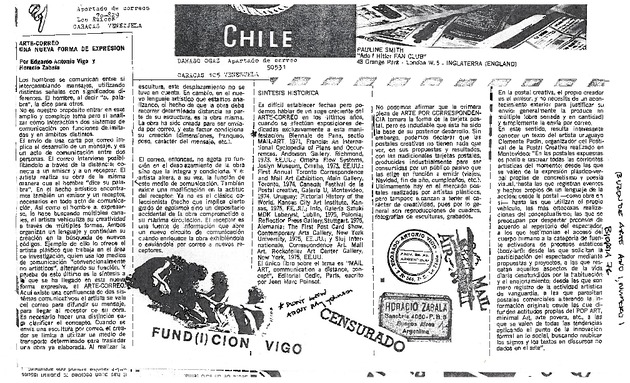
Artecorreo: Una nueva etapa en el proceso revolucionario de la creación (Mail Art: A New Stage in the Revolutionary Process of Creation)
By Edgardo Antonio Vigo, March 1976
Publication: Buzón de Arte
Language: Spanish
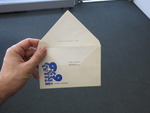
For BUZON DE ARTE (Art Mailbox)
“While currency instability promotes a flow of capital toward functional goods and furniture, while societies speculating in art are founded and prosper, while the art market undergoes increasing integration with the wider system of capitalist, consumerist exchange, an activity such as this (MAIL ART) escapes the system by avoiding it, questioning it partly by affirming it, in today’s world, the viability of a system opposed to the dominant one. Some will take issue with this, objecting that the products discussed here are of minimal importance, that they cannot have any impact on the dominant market system, but this is not where the problem lies. Such artistic production demonstrates in a highly effective way how (even symbolically) every aesthetic activity creates problems at a political and economic level without needing to be located in the realm of ideology and revolutionary programs.”
From: “MAIL ART/ DISTANCE COMMUNICATION/ CONCEPT,” Jean-Marc Poinsot, Nov. 1, 1971, Paris.
This quotation from Poinsot, taken from the only theoretical text in the catalogue of the LAST INTERNATIONAL EXHIBITION OF MAIL ART ’75 (Galería Arte Nuevo, Buenos Aires, December 1975), clarifies the way in which some creators of this brand-new trend of marginal, creative communication are politically committed. This article will not chart the development of this trend, but instead will locate it within the REVOLUTIONARY ART PROCESS (rather than the transitory subversive path).
The importance of marginality is outlined by Hervé Fischer in his book Art et Communication marginale, Balland 1974, France, when he states: “Therefore, MARGINAL MEDIA appear as specific, limited attempts—whether by individuals or minority subgroups of society—to transmit and disseminate REPLIES.” (op. cit. Hervé Fischer, p. 6). This supports Jean Baudrillard’s theory (Pour une critique de l’économie politique du signe—“Requiem pour les media,” Gallimard, 1972, Paris, p. 208), which, referring to MASS MEDIA, informs us: “At present, we offer NO REPLY.”
These media without a reply, as Baudrillard highlights, are composed of all the outlets of mass communication that TRANSMIT without allowing the receiver to REPLY. The spread of the mass media creates a parallel need for TRUE INTERCOMMUNICATION. Some forms of mass media, however, do allow the formulation of a critical dialogue after the event, but without affecting the result, which will continue to be emitted intact (such as in the case of a video or film). This becomes a hollow reply, although it is important to highlight its positive function as a factor that UNLEASHES DIALOGUE.
In MARGINAL COMMUNICATION there is a tendency to reject technology, inclining toward the manual and above all toward A NEED TO COMMUNICATE BETWEEN INDIVIDUALS (“Who is no one?” Edgardo Antonio Vigo, Hexágono ’71, 1972/73, La Plata, Argentina), without requiring a commercial telegraphic, dehumanized TOOL to enable dialogue. This prioritizes a true communication where the perception of the impact of the word or the creative instance constantly re-creates and renews the dialogue, without hiding the array of reactions produced.
Within MARGINAL COMMUNICATION we find DISTANCE contact. This is the current within which MAIL ART is situated. Employing the oldest medium of mass communication (a transmitter of all types of news by the user), MAIL ART has established an international chain of creators that grows day by day.
I do not believe in a “subversive” character, but in one that is revolutionary, a concept that requires clarification. I do not agree that a work can, in itself, be revolutionary. On the contrary, the work is the product of a revolution. I believe in the WHOLE REVOLUTIONARY PROCESS OF ART which, rooted in its nonconformism, demonstrates constant creativity in its experimentation and will be hastily cast aside by the Official, forced into the straitjacket of Mannerism or simply inserted within a REWRITTEN HISTORY OF ART. MAIL ART, alongside numerous investigative contemporary trends, will no doubt be incorporated into this REWRITTEN HISTORY OF ART. These predictions of the future run the risk of being mistaken, as it is known that, left to his own devices, man asserts the abusive right to possess objects and, moreover, is obsessed with collecting and valuing the things he POSSESSES. Besides status, the materialistic conversion of art into an economic object has imbued man with an attitude that lurks out of sight, ready to pounce unexpectedly, seizing ownership of the purest objects in order to bastardize them.
However, this is where we find a COMMITTED ATTITUDE on the part of the MAIL ART practitioner. This lies in remaining at a distance from the siren songs of Museums and Galleries; it lies in escaping the “subtle commercial networks” of collectors; it lies in becoming a “CONSTANT SPEAKER, RECEIVER, AND TRANSMITTER,” not only of the practitioner’s own works, but also of those produced by others. Understood in this way, there is no risk of confusion. This does not even disrupt the results or the fractional logic of pseudo-creators, who, constantly seeking to insert themselves within a tradition, enroll in this current, without principles or conviction, in order to exploit it.
“Mail Art: A New Stage in the Revolutionary Process” is the title of this article, underpinned by a firm belief in the truth of this assertion, founded on mail art’s basis in the following guiding principles:
It establishes new means of communication (using the classic forms of postal communication, being conscious of limitations, creating new languages born of the constant habit of eluding the obstacles thrown in its path: censorship, lack of understanding, losses, absurd rulings, evaluations, etc., etc.);
It is investigative and experimental, as its efforts are recent and its practice constitutes a brand-new form of expression subject to new conditioning factors;
It is aligned with MARGINAL DISTANCE COMMUNICATION, with the favorable divergence of creating in its practitioners the UNAVOIDABLE NEED to enter into direct contact, to feel “ENVELOPED IN A COMMON PURPOSE” and to be RETRANSMITTORS of works created by others;
It ruptures the traditional concept of the “collector” (who is individualistic, commercial, and possessive), transforming this figure into a “MERE TEMPORARY OWNER,” committed to the possibility of new communications that transfer, convey, and disseminate the principles this art represents;
It is revolutionary, uniting with all the historical currents that have broken with accepted forms to create a state of “CONSTANT DISSATISFACTION, WHICH LEADS MAN TO STRIVE FOR IDEALS AND PERFECTION”;
And it contains, in some of its messages, the requisite dose of nonconformism, subversion, global relations, and individual relationships that transform it into a “CRITICAL TESTIMONY OF SOCIO-POLITICAL-ECONOMIC REALITIES,” creating the means of eluding the “Official,” the principal originator of all the traps and difficulties imposed upon Creation.
BUENOS AIRES, DECEMBER 1973
TEXT No. 1
ART RELIES ON ALL THE FIELDS THAT ARE NOT SPECIFICALLY ARTISTIC.
IT IS AN INDEPENDENT, AUTONOMOUS SPHERE ONLY IN TERMS OF ITS OWN POETIC LANGUAGE.
A POETIC LANGUAGE IS A SYSTEM OF MEANING FOR THE COMMUNICATION OF IDEAS.
IT EXISTS THROUGH CONSTANT INVESTIGATION AND EXPERIMENTATION, OR IT CEASES TO BE POETIC.
ARTISTIC PRACTICE CONSISTS IN THE INTEGRATION OF AN INVESTIGATIVE POETIC LANGUAGE AND A CLEAR, CONCRETE POLITICAL IDEOLOGY.
IF THE ARTISTIC PRODUCT IS THE RESULT OF THE SEARCH FOR IDEAS FELT OR THOUGHT BY ALL (IN NON-ARTISTIC SPHERES), IT WILL BE CONFIRMED AS SUCH IN THE MINDS OF THE PARTICIPATING SPECTATORS, WHO ULTIMATELY VERIFY THE NEED FOR ITS EXISTENCE.
THE ARTISTIC PRODUCT WILL THEREFORE BE THE OUTWARD EXPRESSION OF THE CONNECTIONS COMMONLY MADE IN OUR MINDS.
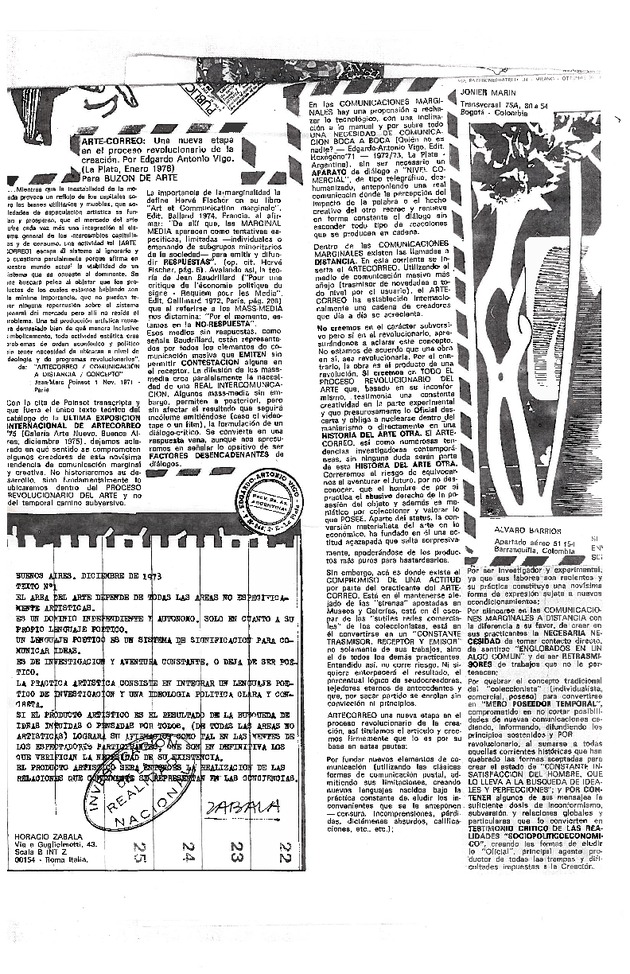
MAIL ART STATEMENT: DO NOT ACCEPTE [sic] CONFORMITY BUT REFUSE PROPOSALS MADE BY SYSTEM
1981
Publication: Self-published
Language: Spanish/English
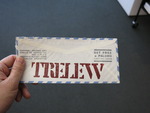
“DISTANCE COMMUNICATION (MAIL ART)” should not only transgress the regulations of the post office. It should also create “COUNTER-INFORMATION,” transforming its practitioner into an “ACTIVE COMBATIVE PARTICIPANT” who denounces the aberrations of the national and international systems that enslave man.
Fighting against torture, subjugation, persecution, death, disappearance, and all the “SYSTEMATIC CODIFICATIONS” that restrict man’s creative freedom. Ensuring that “MARGINAL PRACTICES” bear witness to and support contemporary events from the front line, shattering the traditional “politics” of the writer-scribe, a narrator, usually, of past events and uncommitted documenter of the already concluded.
In what Regarding the “LATIN AMERICAN GHETTO,” the fight should be focused against the “RISING AND SUFFOCATING FASCIST SMOG,” a loyal patron of all those models whose function is to destroy all efforts toward creativity and testimony. A creativity that does not give up its underground battle to keep alive the flame of ideological thoughts that nullify paternalistic police control.
Lea el texto en español aquí.
- 1Vigo’s references contain slight errors. He refers to Galeria MDK Labirynt, Lublin; First New York City Postcard Show. Contemporary Arts Gallery, New York University; and Sluj International, Michael C. Rockefeller Arts Center, Fredonia, NY.
- 2Vigo here refers to C.E.D.I.C.
